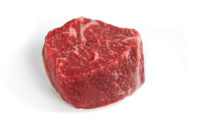What's In A Name?
Despite the odd moniker, consumers have learned to depend on No Name for quality meats.
Sometimes, the best brand name is no name at all. At least, that’s what made No Name® Steaks a culinary favorite in a small Minnesota neighborhood. And since adding the No Name brand to its business, J&B Group of St. Michael, MN, has brought the oddly named steaks to popularity throughout the Midwest.
The No Name steaks originally gathered momentum by word of mouth. Years later, even though J&B Group does a combination of television, radio, and other advertising, it’s still the most effective method.
“We find that consumers talking about their No Name experience with their neighbors or their relations is probably the strongest and best way we have of expanding our product,” says Bob Hageman, chief executive officer. He co-founded the company in 1979, starting J&B out of his basement.
The company now operates four revenue-generating business units:
Production: Producing custom and stock cuts for retailers and the foodservice industry.
Third-party logistics: Services such as cold storage, cross stock, and transportation.
Distribution: Purchasing product from other vendors and using its warehouse as a mixing warehouse for redistribution.
Branded Products: Including the No Name products, a Midwest Pride brand, and a new Blue Wave seafood brand.
The company’s headquarters consists of two buildings, a production facility and a freezer, that total about 250,000 square feet. There is also a dry-aging facility in St. Michael, a smoked meats facility in Montrose, an overflow freezer in Detroit Lakes, and several satellite offices in the Midwest.
No Name products, which include steaks, pork chops, salmon, and poultry cuts, are the most well-known items J&B Group produces, but there is much more to the company’s capabilities, notes Russ Sjoquist, vice president of production.
“We do foodservice portion cuts for several major foodservice distributors, and we also do a lot of frozen marinated and non-marinated steak production for foodservice,” he says. The company also produces a variety of meats for retail bulk value-added programs, as well as a retail tray-pack pork product line.
A steak with no name
The story of how the No Name steak got its start is one of the things that draws consumers to the product. More than 35 years ago, a local butcher wanted to come up with a steak that cooked tender and juicy every time. After much experimenting, he came up with the ideal steak and began selling them at his shop. When customers started asking what kind of steaks they were, he said they had no name.
The best part of the story is that it’s absolutely true. When J&B Group acquired the brand in 1993, the No Name steaks were still being produced out of a little neighborhood butcher shop.
“I was selling them loads of one particular raw material, but I had never visited the facility,” explains Mike Hageman, president, who was working in sales at the time. “One day I went down there, just to see where all this product was going. I actually drove by their plant, because I thought it couldn’t be it. It was this little butcher shop sitting in the middle of a residential neighborhood.”
That was about the time when local retailers started taking an interest in the No Name product. The shop was outgrowing its capacity, and J&B Group was better suited to invest in the infrastructure to take the steaks to the next level. The company purchased the brand and moved operations up to its St. Michael facility.
J&B Group has used the steak’s beginning heavily in its marketing plan. Kurt Anderson, vice president of distribution, says that the story of the “little guy” who made good intrigues people. It also gets them past the hurdle of wondering why the steaks are named “No Name.”
“They have that question because it has no name, and then when they find out why it got the name No Name, they’re even more interested in trying it,” he explains.
The first attempt to market No Name steaks came a few years after the original purchase, when J&B Group sold product to retailers in California and elsewhere on the West Coast. The company ended up pulling out of those markets a few years later and re-introduced the steaks in a 10-state region in the Midwest, where the brand is currently marketed.
“We had a flawed matrix that we were operating under,” says Bob Hageman. “We didn’t realize the amount of money it was going to take to get that first piece into somebody’s mouth. It cost about four or five times as much as we thought before we went into the marketplace.”
Mike Hageman adds, “The other thing that was most insightful was that we couldn’t expand with just the two product offerings that we had [the original and petite cuts]. So back in 1999, when we pulled out of those markets and looked at this region, our main initiative was to expand the product line, to make sure we had enough products, whether it was on the shelf or in R&D.”
Since then, J&B has been continuously expanding the No Name brand from steaks, to the point that there are about 25 products in the brand. The expansion has continued this past year with several new product releases.
From freezer to fresh
One of J&B Group’s boldest initiatives is to add the No Name brand to the fresh meat case with a new line of Butcher’s Secret Recipe cuts. The six new products are all trimmed, marinated, seasoned and oven-ready in a bakeable tray. The varieties include a Roasted Garlic & Peppercorn Chicken Breast, Herb & Garlic Chicken Breast, Cajun-Style Pork Chops, Italian-Style Pork Chops, Seasoned Grill Sirloin Steaks, and Burgundy Peppercorn Sirloin Fillets.
Mike Hageman says that the company researched where consumers were spending their dollars at the supermarket. By adding the Butcher’s Secret line, the company was able to secure some space in the fresh case.
“We also thought this would be a great way [for consumers] to try the No Name product,” he adds. “Then, they might be more open to trying some of our frozen steaks, our smoked meats, and some of the other products within the case.”
After mastering the production of frozen steaks, J&B had to make some changes to produce the best fresh cuts possible.
“With the frozen No Name products, you’re doing simple production runs, and as you’re doing it, you’re freezing and inventorying it,” says Sjoquist. “With this product, it’s on a pre-sold basis; we don’t inventory it. We require the retail distributor to pre-order it, and we produce it to order to maximize the shelf life they have on it.”
Anderson points out that J&B had been doing similar things with its foodservice sales, where the company sold cut-to-stock and custom-order steaks. That mindset was adapted to fit the retail side of the business.
The Butcher’s Secret products are currently available only locally, while the company does consumer research on the products before rolling it out to other markets.
“It’s to make sure we’re hitting the mark from the consumer perspective,” Hageman says. “Not only if we’re hitting the mark being in the fresh case, because that’s a new case for us, but also in the flavor profiles themselves.”
So far, retailers have welcomed the concept, he adds. Consumers are always looking for new and innovative profiles and new flavor profiles.
“As a retailer, you want to continue to renew your case and look for exciting new products. For the most part, this really fit that need,” Hageman says.
The Butcher’s Secret products are just one of the new product releases in the work. To complement the frozen No Name salmon fillets, the company is also introducing frozen tilapia fillets. Hageman notes that a great deal of research and development is being done into adding seafood items to the line.
J&B Group also purchased deBarbeque Inc. last year, adding a line of ribs to the No Name family. The company actually had been a customer of J&B Group that had specialized in the foodservice side of the business. Now, J&B is bringing it into the retail arena.
“It was a wonderful product, and it seemed like a natural fit to take that product and add it to our No Name line,” Hageman says. The rib, sold under the Bare Naked Ribs name, is a dry-rubbed rib — a large point of differentiation from the competition, which predominantly offers pre-sauced ribs.
“You can put one sauce out there and get five different opinions on it,” Anderson notes, “whereas if you like one sauce and have a bare naked rib to put it on, then you get the best of both worlds. Some people like their ribs sauced on the grill, and then some people like to take their ribs and dip them into the sauce. You’ve got all your options available with this rib.”
Hageman says that the company generally has three or four products in development at any given time, but the company is very careful in what it releases under the No Name brand.
“We have some consideration of cannibalization as we introduce products,” he says. “We want to make sure that it’s another purchase, and not a replacement purchase for some of the other items that are already in the case.”
It is also careful to preserve the quality behind the No Name brand.
“The more products you put out there, and the greater name recognition you have, the more concern you have of the product you’re putting out there,” says Sjoquist. “If a consumer has a bad experience with it, you run the risk of tarnishing the rest of your items.”
Well-managed growth
In the Minnesota market, several significant competitors on the distribution side have gone out of business in recent years. Hageman says that J&B Group has experienced strong growth in recent years.
“We had been busy setting a foundation, so as future growth continued to occur, we’d be able to take it on efficiently and profitably,” he explains. “The last five years have been a combination of taking the opportunities that the marketplace presented due to the closures, as well as continuing to build the foundation of a solid company that could handle future growth.”
One of the company’s biggest changes was to expand their relationships with several key customers.
“For twenty years, we’ve always played a secondary role [as a distributor],” says Hageman. “As our customers grew and wanted us as their primary distributor, some of their service requirements changed substantially from where we had been as a secondary supplier. It brought in more discipline to our business.”
The company also has added a level of technology not usually seen in a company of its size. It can monitor the cold chain from the moment the product is received to the time it’s delivered to the customer.
“We monitor the receiving of the loads and make sure it’s in the proper refrigerated or frozen environment,” Sjoquist notes. “We added the temperature-tracking technology into our trailers, so we can have constant reading on the temperature within the box. We can ensure that when it gets to our customers, it’s going to be in the proper condition.”
J&B has utilized this technology for about five years. Anderson, who was involved in incorporating the technology into J&B’s production and transportation, also notes its usefulness in case of product recalls.
“It’s only as good as the trackability the vendor has on his product,” he explains. “If they track by case or lot, we can track by case or by lot. We can call up a customer and say, ‘You’ve got ten cases of short loins in your cooler.’ Of those ten cases, we can tell him the three cases we need back.” That technology eliminates the need for a mass recall and the negative publicity that can come from that.
The temperature-tracking abilities are one part of a system that maintains J&B’s high standards of food quality and safety. The company was also one of the first steak manufacturers to use a wash system on the cutting line that kills E. coli.
“We feel strongly that food safety is going to be the differentiator in the industry,” Hageman says. “It’s going to be those that can versus those that cannot.” NP
J&B Group
St. Michael, MN
Founded in 1979
2005 Sales: Over $400 million
Employees: About 420
Facilities: Two buildings on the main campus, totaling about 250,000, as well as other facilities throughout Minnesota and offices in the Midwest
Brands: No Name, which includes about 25 different frozen and fresh products; Midwest Pride meats and deli products; Blue Wave seafood products; deBarbeque Inc. ribs.







